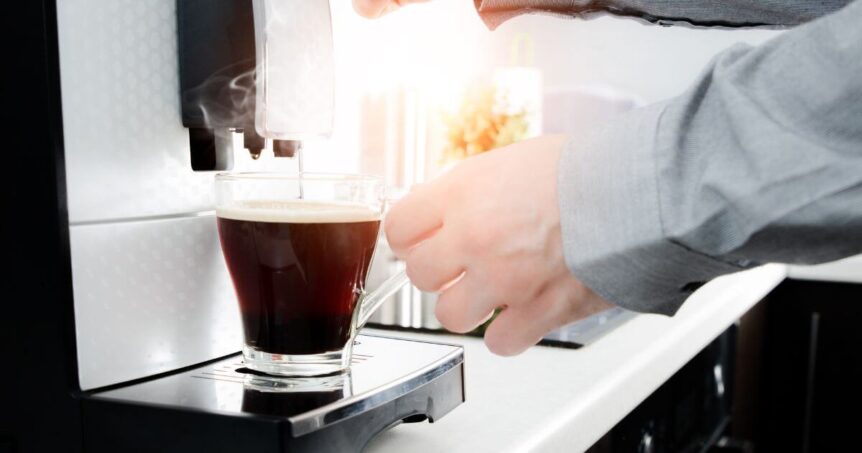Lungo coffee is just a longer extracted version of espresso made by tweaking grind size and brew ratios. It boasts a bold and robust flavor profile with a slightly milder intensity compared to espresso, offering a rich, full-bodied taste that lingers on the palate.
The world of espresso can be vast, complex, and, more often than not, confusing. But it doesn’t have to be that way.
In this guide, we will explore the ins and outs of the infamous cousin of espresso, the Lungo, and everything you need to know about modern Lungo coffee.
Let’s dive in!
What Is Lungo Coffee?
Lungo simply means “Long” in Italian and refers to a style of espresso that is extracted longer than your everyday expresso.
However, longer coffee extraction isn’t just about increasing the volume. Rather it involves accurately adjusting the grind size and brew ratio.
Lungo is like a tamer version of espresso, but don’t let that fool you! With the extended extraction time, it brings out more of those awesome coffee flavors, making the overall taste pack a punch.
Moreover, it shouldn’t be confused with espresso double shot or Americano, which are totally different drinks.
What Is Lungo Coffee Made Of?
Lungo has the same ingredients as regular espresso, coffee beans, and some handy work on espresso machines. The only difference is the higher extraction time and brew ratio, which is typically 1:2.5 – 4+.
Not sure what the brew ratio is? It’s a ratio of the amount of coffee ground to water. A 1:15 ratio means using 1g of coffee per 15g of water. It’s the secret to getting that perfect taste and strength in your cup.
What Kind Of Beans Or Grounds Are Used For A Good Lungo Coffee?
We recommend using medium to dark roasted coffee beans for a perfect Lungo. These roasts tend to bring out the rich and bold flavors that work well with the longer extraction time of a Lungo. The coffee grind should be fine but slightly coarser than the one used for espresso to ensure proper extraction.
What Are the Differences Between Ristretto, Espresso, And Lungo?
Ristretto and Lungo are both cousins of Espresso but have totally different flavor profiles.
Ristretto means restricted flow and is made using finer coffee grounds, yielding better extraction and thicker consistency. The ristretto brew ratio is 1:1 to 1.5, and tastes intensely rich, full-bodied, and bittersweet.
Espresso uses a slightly coarser grind than ristretto. The brew ratio should be around 1:1.5 to 2.5, resulting in a well-balanced, bold flavor with a touch of bitterness.
Lungo requires a coarser grind than espresso and ristretto, but don’t forget it’s still finely ground, just not as much. The brew ratio is 1:2.5 to 4, resulting in a more diluted and mellow coffee, yet it still packs a punch with its bold flavor due to the longer extraction time.
Many people think that the time of pulling a shot determines whether it’s a ristretto, espresso, or lungo, but it’s not that simple. Pulling a long shot doesn’t guarantee a Lungo. It’s all about the coffee grind and brew ratio. We’ll dive into the details in the next section.
What Is the Difference Between Lungo And Americano?
Lungo is an espresso-style coffee that you get directly from an espresso machine without any extra ingredients. You’ll get Lungo by dialing in grind size, brew ratio, and extraction time. On the contrary, Americano is made by adding water to a regular espresso shot.
The History of Lungo Coffee

Nobody knows the exact year when Lungo coffee started gaining popularity, but experts suggest it was the early 20th century in Italy. Lungo gained popularity in Europe and has since become a recognized and enjoyed coffee style worldwide.
Who Invented Lungo Coffee?
The exact inventor of Lungo coffee is unknown. All we know is that it became popular in the 20th century in Europe. Our guess is that the invention of Lungo coffee was probably driven by folks wanting a smoother and less hardcore espresso experience.
Where Is the Lungo Coffee From?
Lungo originates from Italy, which is famous for its rich and exciting coffee culture. It gained popularity in America through the growing interest in specialty coffee and the influence of various coffee shops nationwide. Moreover, Nespresso and Starbucks also helped make it a trend in the USA.
How Much Caffeine Is in A Lungo Coffee?
A Lungo shot typically contains 60-80 mg of caffeine which is not much different than a regular espresso shot. But hey, keep in mind that the caffeine content in a lungo depends on many variables, like the type of beans, the amount of coffee ground, and how it’s brewed.
How Many Calories Are in A Lungo Coffee?
A standard lungo shot without any additions typically contains only a few calories, usually ranging from 1 to 3 calories. So, it’s a pretty low-calorie option to enjoy!
How Is Lungo Coffee Made?

Lungo isn’t difficult to brew if you know the basis of espresso. There are many methods out there, but we recommend the following as it brings the classic sweetness, acidity, and bitterness of Lungo every time you pull the shot.
Step: 1 Coffee Grind
Take 17 g of coffee dose and grind it. Since we aim for a higher yield and slightly longer extraction time, the coffee grind setting will be slightly coarser than the standard espresso.
This will help in increasing the flow in the coffee puck and better extraction. Don’t forget to evenly distribute and tamp the coffee cake in the portafilter.
Step: 2 Perfecting the Brew Ratio
For lungo, our brew ratio will be 1:4, which means we expect 68 g of final coffee in the cup. Use a coffee scale for accurate measurements.
Step: 3 Extraction Time
It’ll take approximately 28 sec to pull the shot to match the exact yield. Sometimes it may take longer or shorter depending on the coffee bean type and the grind size. Don’t read too much into it. Focus on the final yield and puck preparation, and you’ll have the perfect Lungo shot.

Equipment
- Espresso machine
- Burr Grinder
Ingredients
- Freshly roasted coffee beans (preferably mild to dark roast)
Instructions
- To get started, grind 17 g of coffee beans, slightly coarser than what you would use for espresso. Our targeted brew ratio is 1:4, which means we want 68 g of the final yield.
- Turn on your espresso machine and let it heat to reach the ideal hot water temperature.
- Scoop the desired amount of coffee grounds into the portafilter, ensuring a level surface. Give it a firm tamp to create a compact, even ground bed.
- Reattach the portafilter to the espresso machine, making sure it is securely in place. Position a preheated espresso cup under the portafilter spout to collect the delicious brewed espresso.
- Initiate the extraction by pressing the brew button or pulling the lever, allowing the espresso to flow steadily from the portafilter into the cup.
- Aim for an extraction time of approximately 28 seconds, using a coffee scale to measure a desired yield of around 68 grams. Adjust the grind size and extraction time as needed to achieve the desired yield.
What Are Some Common Ways to Enjoy Lungo Coffee?
Lungo is best enjoyed solo fresh from an espresso machine. Some enjoy lungo as the base for specialty coffee drinks like lattes, cappuccinos, or Americanos. Ultimately, choosing how to enjoy Lungo coffee is up to you!v
Frequently Asked Questions
Is Lungo Stronger Than Espresso?
Not necessarily, as it contains the same amount of coffee beans, aka caffeine, and the difference is just in the brew ratio and grind size. In terms of taste, it’s actually milder, but a longer extraction time does bring out more flavors.
Can You Add Milk to A Lungo?
Yes, you can, but it’s generally enjoyed as a standalone drink.
Is Lungo Bitter Than Espresso?
Yes, the longer extraction time of Lungo means more bioactive ingredients in coffee beans end up in your cup, making it a tad more bitter. However, bitterness is not a bad thing, and it adds complexity to the overall flavor.
Is Lungo Good for Latte?
Yes, lungo can be a good base for a latte as it offers a slightly milder and more balanced flavor than espresso. However, keep in mind that since a latte already contains a significant amount of milk, using lungo might result in a more pronounced milky taste than desired.
Summary
Lungo is for those who prefer a longer, gentler coffee experience. We’ve discussed the slight nuances in this definition and recipes in this guide which will help you understand the intricate details of espresso making.

